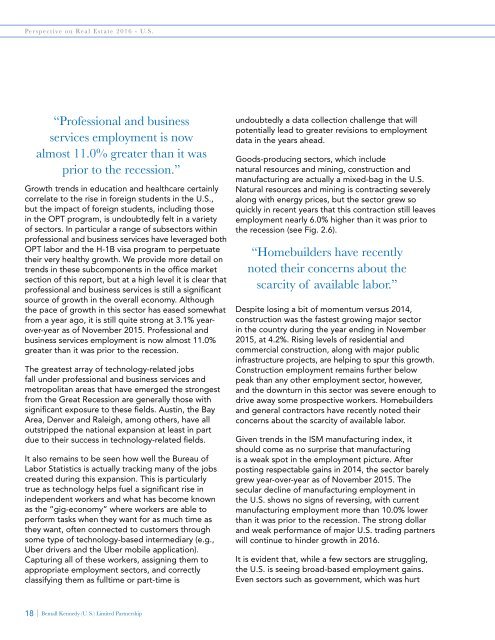BK Perspective Real Estate USA 2016
Create successful ePaper yourself
Turn your PDF publications into a flip-book with our unique Google optimized e-Paper software.
<strong>Perspective</strong> on <strong>Real</strong> <strong>Estate</strong> <strong>2016</strong> - U.S.<br />
“Professional and business<br />
services employment is now<br />
almost 11.0% greater than it was<br />
prior to the recession.”<br />
Growth trends in education and healthcare certainly<br />
correlate to the rise in foreign students in the U.S.,<br />
but the impact of foreign students, including those<br />
in the OPT program, is undoubtedly felt in a variety<br />
of sectors. In particular a range of subsectors within<br />
professional and business services have leveraged both<br />
OPT labor and the H-1B visa program to perpetuate<br />
their very healthy growth. We provide more detail on<br />
trends in these subcomponents in the office market<br />
section of this report, but at a high level it is clear that<br />
professional and business services is still a significant<br />
source of growth in the overall economy. Although<br />
the pace of growth in this sector has eased somewhat<br />
from a year ago, it is still quite strong at 3.1% yearover-year<br />
as of November 2015. Professional and<br />
business services employment is now almost 11.0%<br />
greater than it was prior to the recession.<br />
The greatest array of technology-related jobs<br />
fall under professional and business services and<br />
metropolitan areas that have emerged the strongest<br />
from the Great Recession are generally those with<br />
significant exposure to these fields. Austin, the Bay<br />
Area, Denver and Raleigh, among others, have all<br />
outstripped the national expansion at least in part<br />
due to their success in technology-related fields.<br />
It also remains to be seen how well the Bureau of<br />
Labor Statistics is actually tracking many of the jobs<br />
created during this expansion. This is particularly<br />
true as technology helps fuel a significant rise in<br />
independent workers and what has become known<br />
as the “gig-economy” where workers are able to<br />
perform tasks when they want for as much time as<br />
they want, often connected to customers through<br />
some type of technology-based intermediary (e.g.,<br />
Uber drivers and the Uber mobile application).<br />
Capturing all of these workers, assigning them to<br />
appropriate employment sectors, and correctly<br />
classifying them as fulltime or part-time is<br />
undoubtedly a data collection challenge that will<br />
potentially lead to greater revisions to employment<br />
data in the years ahead.<br />
Goods-producing sectors, which include<br />
natural resources and mining, construction and<br />
manufacturing are actually a mixed-bag in the U.S.<br />
Natural resources and mining is contracting severely<br />
along with energy prices, but the sector grew so<br />
quickly in recent years that this contraction still leaves<br />
employment nearly 6.0% higher than it was prior to<br />
the recession (see Fig. 2.6).<br />
“Homebuilders have recently<br />
noted their concerns about the<br />
scarcity of available labor.”<br />
Despite losing a bit of momentum versus 2014,<br />
construction was the fastest growing major sector<br />
in the country during the year ending in November<br />
2015, at 4.2%. Rising levels of residential and<br />
commercial construction, along with major public<br />
infrastructure projects, are helping to spur this growth.<br />
Construction employment remains further below<br />
peak than any other employment sector, however,<br />
and the downturn in this sector was severe enough to<br />
drive away some prospective workers. Homebuilders<br />
and general contractors have recently noted their<br />
concerns about the scarcity of available labor.<br />
Given trends in the ISM manufacturing index, it<br />
should come as no surprise that manufacturing<br />
is a weak spot in the employment picture. After<br />
posting respectable gains in 2014, the sector barely<br />
grew year-over-year as of November 2015. The<br />
secular decline of manufacturing employment in<br />
the U.S. shows no signs of reversing, with current<br />
manufacturing employment more than 10.0% lower<br />
than it was prior to the recession. The strong dollar<br />
and weak performance of major U.S. trading partners<br />
will continue to hinder growth in <strong>2016</strong>.<br />
It is evident that, while a few sectors are struggling,<br />
the U.S. is seeing broad-based employment gains.<br />
Even sectors such as government, which was hurt<br />
18 | Bentall Kennedy (U.S.) Limited Partnership


